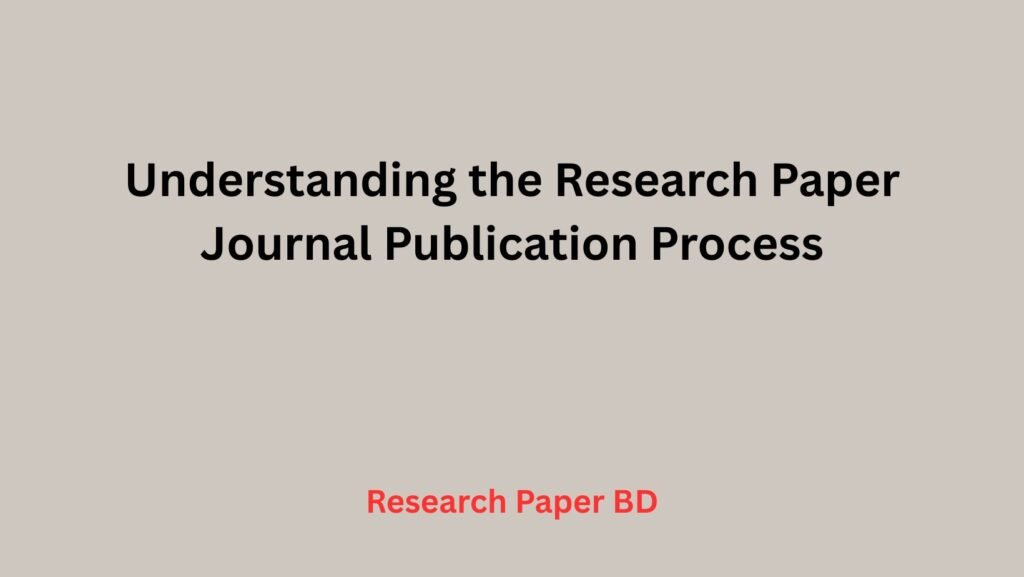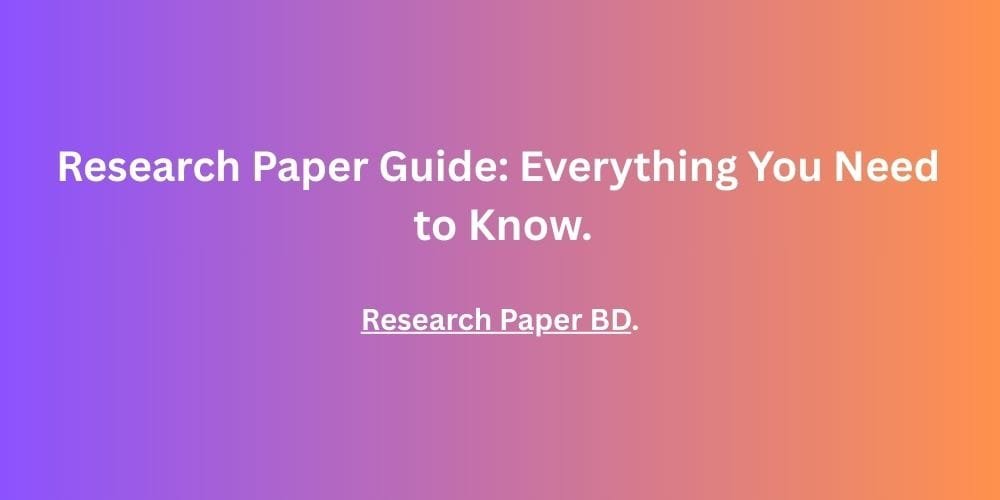Research paper journal publication process is an important part of scholarly work that involves multiple critical steps. The publication of a research paper in a peer-reviewed journal not only validates your findings but also contributes to the cumulative body of knowledge in your field. However, the process can be complex and confusing—especially for new or even experienced researchers—due to the several stages involved. This detailed guide breaks down every part of the publication journey, from developing a research idea to successfully publishing your paper in a peer-reviewed journal, helping you navigate the process with clarity and confidence.

How to Prepare Your Research Paper for Publication
Preparation is the key to any successful publication. The most innovative ideas can even be refused if they are not proposed clearly, briefly and following the academic style. Here’s how to get your manuscript ready.
1.1 Pursuing Research That Is Rigorous and Original
The first part of the journal publication process takes place well before you start writing—namely, at the research stage. This may refer to seeking out a gap in the existing literature and which you want to address, creating a hypothesis or a research question, collecting data, and drawing a conclusion.
Key points to consider:
Novelty: Your study has to present something new — be it new theory, method, or empirical finding.
Relevance: Make sure your topic is current and relevant to current discussions or problems in your field.
Ethics committee approval: If your work contains studies with human or animal subjects, please ensure that you have provided the required ethical ‘evidence of approval by an ethics committee’.
Best practices:
- Record your procedure with meticulous detail.
- Utilize good methods of data collection and analysis.
- Read and understand the previous work by doing a thorough literature review.
1.2 Organization and Writing of the Manuscript
The vast majority of journals will assume papers are following this structured format.
Introduction Provide background to the study, identify the gaps in the literature and the research objectives.
Methods: Explain how you conducted your study, including your sample, instruments, and data analysis methods.
Results: Reflect the waking results directly including the tables, diagrams and figures.
Discussion: Analyze the results, compare with previous studies, and indicate the implications.
Conclusions: Summaries principal findings and suggest implications for future research.
Don’t forget:
- Title It Attractive and Informative (Keyword Rich).
- Write a short, sweet abstract (150-250 words) summarizing your study in an abstract.
- Choose keywords wisely to enhance discoverability on platforms such as Scopus and Google Scholar.
1.3 Editing, Proofreading, and Copy-editing
Mistakes in grammar, style, and structure will get your book rejected, no matter how good the writing is.
Recommendations:
- Try the grammar checkers such as Grammarly or Pro Writing Aid.
- Get colleagues or professional editors to read your manuscript.
- Re-check your formatting with the target journal author guidelines, in term of font, references type and headings.
Choosing the Right Journal
Journal selection is very important. 2 ) Lack of fit between your manuscript and the scope of the journal Something that contributes significantly to desk rejections (rejections without peer review), is when there’s a lack of fit between your manuscript and the journal’s scope.
2.1 How a Journal is Selected
Scope and Focus: Make sure your subject is relevant to the journal’s aims. For instance, an article on sustainable agriculture does not belong in a journal ON theoretical economics.
Impact Factor and Indexing: A greater prestige, can be expected of manifestations indexed in Web of Science, Scopus, PUBMED, Journals with Impact Factor also have greater prestige.
Peer Review Process and Turnaround Time: Check if the journal has a single-blind, double-blind or open peer review process. Journals with quicker turnaround times are ideal if time is an issue.
Open Access vs Subscription:
- Open Access: Broader access, but also potentially involves APCs.
- Subscription-Based: Free for publishers to write, but restricted for readers.
2.2 Tools and Resources for Journal Analysis
There are several tools that help you to identify potential journals for your abstract or manuscript:
- Elsevier Journal Finder
- Springer Journal Suggested
- Journal Guide
- SC imago Journal Rank (SJR)
Always look at the acceptance rate of the journal, the reputation of the editorial board and the submission guidelines as the first step before picking the right one.
Submitting Your Manuscript
There’s more to submitting a paper than uploading it. It is a process that is more than one step, and it takes care and skill.
3.1 What Needs to Be Ready Before You Submit
Standard requirements are as follows:
Manuscript (usually a Word or LaTeX file is acceptable).
Cover Letter: Introduce your work and explain why it suits the journal Contents and Methods: Briefly summarizes the paper and gives main methods Bibliographic Summary: Brief summary of what is already known (skip if already given in first cover letter to another journal) 4.
Conflict of Interest Statement.
- Ethics Approval Certificates (where required).
- Author Contributions Statement.
- Figures and tables may be submitted in the following formats (JPEG, TIFF, EPS).
- Read the journal’s submission checklist carefully to avoid making common mistakes.
3.2 How to Write a Cover Letter that Works
- Your cover letter should:
- Can you describe the rationale behind your study and its main findings?
- Reasons for being a good fit for the journal.
- Disclose any conflicts of interest or funding sources.
- Please ensure that the article is not simultaneously being considered by or has been published in another journal.
- A smartly written cover letter can pique the editor’s interest in you and increase your chances of getting published — so don’t make it an afterthought.
The Peer Review Process
Peer review is the cornerstone of scholarly publishing. It guarantees your research is foolproof, unique and relevant.
4.1 Editorial Review and Desk Rejection On the editorial level, there are effectively two passage 116 of 210
- Upon submission, the editor conducts a first review of the submission in order to determine:
- Relevance to the scope of the journal.
- Conformity to formats and styles.
- Existence of plagiarism through Turnitin or Ithenticate.
- In case major flaws are identified, your paper may be desk-rejected without further reviewing.
4.2 Overview of the Peer Review: Categories and Schedule
If your manuscript passes through the initial screen, it’s on to peer review.
Types of Peer Review:
Single-Blind: Reviewers can see whose paper they are reviewing, but authors don’t know that reviewers will review their paper.
DOUBLE BLIND: Is where both participant’s and experimenter’s identities are concealed.
Open Peer Review: identities known to both reviewer and author.
Review process can last from 1 to 6 months depending on the speed of the journal and the reviewers.
4.3 Possible Outcomes
Next, the editor will decide one of the following:
Accept: Unusual in first pass.
- Small changes requested.
- Major Revisions: There needs to be major revisions.
- Reject and Resubmit: Recommends revision on a massive scale for a future submission.
Decline: The manuscript is inappropriate for its current form of submission. Submitting a Revision of Your Manuscript
Time to strengthen your paper with sharp feedback.
5.1 Responses to Reviewers’ Comments
- Develop an extensive letter of response that, as a minimum:
- Responds to each comment personally.
- Clearly articulates what got changed or why it wasn’t.
- Carefully worded and professional.
Pro tip: If there are color-coded revisions or tracked changes in the new version, they can make the updates more visible.
5.2 Revised Manuscript Submission
Submit your revised version with the following:
- The tracked-changes document.
- Revised manuscript in a clean version.
- The response letter.
- Please follow all of the instructions closely so that this will not cause any delay in obtaining further evaluation.
Acceptance and Future Publication
6.1 Final Approval and Copyright Assignment
After acceptance of your manuscript:
- You will be asked to sign a copyright agreement or open-access license.
- Some journal editors might ask for a graphical abstract or video abstract.
6.2 Proof-reading and Production
Your article is heading into production:
- Copy editors read for formatting, grammar and style.
- Page proofs for checking of final errors will be sent.
- You must also review the final copy before it is published.
6.3 Offline and Online publication
After final approval:
- Your paper is assigned a DOI.
- Online publication (published online before issue publication or only online).
- Crawler run indexed and citable.
- It may be published in a future printed issue depending on the journal.
- How to Promote Your Published Work
Publishing is the easy part. Visibility leads to impact.
7.1 Promotion through Digital and Social Media
- Post your paper on LinkedIn, Twitter/X, and Facebook.
- Make a thread to discuss important take-aways or what you think will happen.
- Tag your co-authors and institution.
7.2 Academic Communities and Conferences
- You could upload to ResearchGate, Academia. edu, and Google Scholar.
- Participate in webinars, workshops, or conferences.
- Add to university repository or course syllabus.
7.3 Boost Citations and Increase Reach
- Employ resources such as Altimetric to monitor media and online coverage.
- Contact journalists or science communicators.
- Refer to your work in subsequent writings as arising in it.
8. Common Challenges and Solutions
| Challenge | Solution |
| Repeated Rejections | Revise thoroughly, select more suitable journals. |
| Language or Grammar Issues | Hire a language editor or use premium grammar tools. |
| Long Review Timelines | Check journal average times; follow up politely if delayed. |
| Predatory Journals | Use COPE, DOAJ, or consult senior researchers for guidance. |
| Authorship Disputes | Discuss roles and order of authorship early in the research process. |
Ethical Considerations in Academic Publishing
Academic integrity is non-negotiable.
9.1 Fraud and Data Fabrication
- Always cite sources properly.
- There is software for testing against plagiarism.
- No data should ever be faked or manipulated.
- Authorship and Contribution9.2.
- And list only those who were meaningfully involved in the work.
9.3 Transparency and Reporting Transparency and disclosure constitute the most important elements of.
Disclose:
- Funding sources.
- Conflicts of interest.
- Ethical approvals.
Ethical breaches might result in the retraction of articles and even significant reputational damage, as well as degradation of academic esteem.
Concluding: How to Get Your Journal Article Published With Assurance
The path to getting a study published in a journal is hard — but it’s far from impossible. Every step along the way, from coming up with your research question to publication, from learning the research process as an undergraduate to seeking grant funding, contributes to your academic identity and professional life. After reading this article, you will know how to publish a research paper in a journal without any mistakes and improve your chances of getting published.
Posted By Research Paper BD
Contact For Research Help : 01763-437759
We hope this comprehensive guide to the research paper journal publication process has provided you with the clarity and confidence needed to navigate each stage—feel free to share your thoughts or questions in the comments below.


It’s wow
Solid article! which is huge for informed decisions. Good read!
A research article should have a clear understanding, so this writing is good to understand.
It’s so important to learn about resear writing great writing
Interesting read! Understanding research
Interesting points about research writing
Really interesting read!
Great article! smart article
what a article !
Really insightful article!
Interesting points for everyone
That’s a great point about research publications